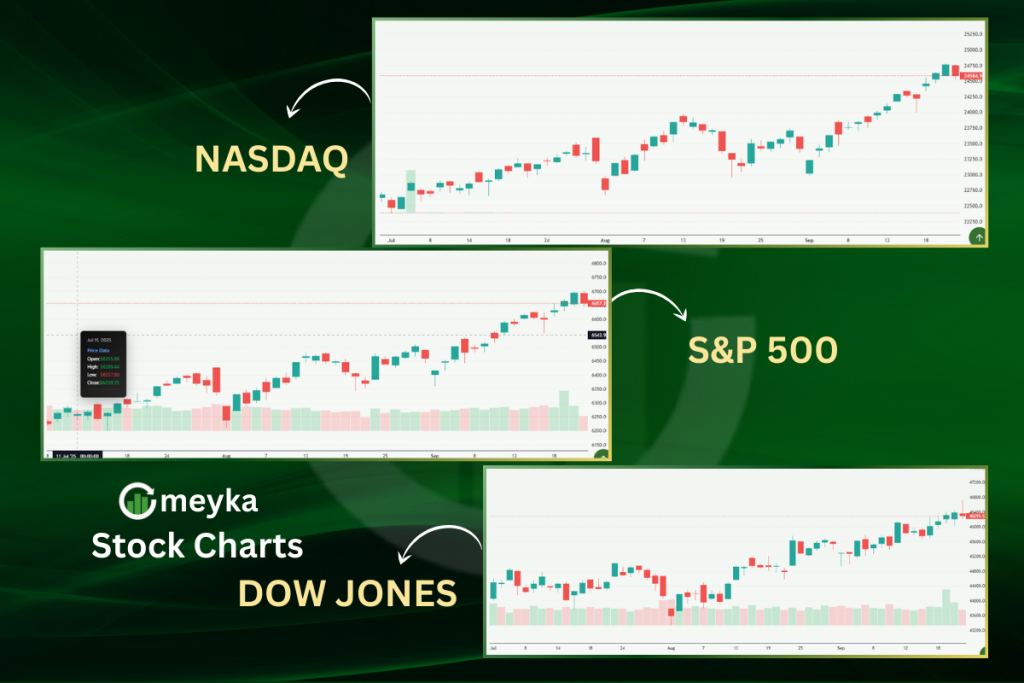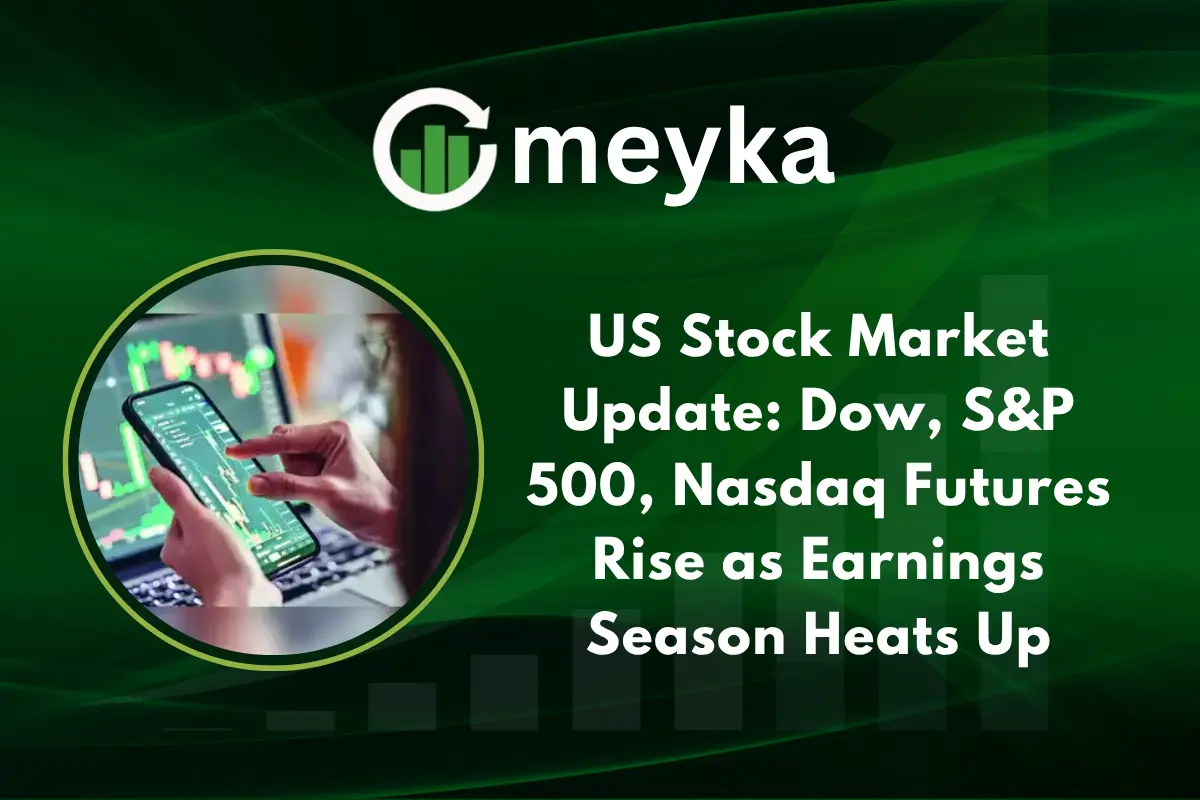US Stock Market Update: Dow, S&P 500, Nasdaq Futures Rise as Earnings Season Heats Up
This US Stock Market Update opens on a positive note. Dow, S&P 500, and Nasdaq futures traded higher in early action. Traders look to big earnings from names like Bank of America, Tesla, and Netflix. Markets are cautious, yet hopeful.
Recent volatility from trade tension and Fed signals has calmed a bit. Still, investors are watching inflation and central bank chatter closely.
Earnings will set the tone for the week, and today’s futures move shows market participants are leaning toward a risk-on stance.
US Stock Market Update Shows Gains Ahead of Earnings Season

In the morning session, US stock futures rose modestly. Dow futures added about 0.25%, S&P 500 futures ticked up 0.30%, and Nasdaq 100 futures gained roughly 0.40%. Markets reacted to upbeat corporate previews and steady economic reads.
Investors are positioning for a heavy slate of corporate reports. Energy, tech, and finance names are in focus as companies reveal their quarter results and guidance.
Why are futures up today?
Many traders expect steady profits and clearer guidance. Better-than-feared economic data also helped. Algorithmic models picked up early momentum, prompting some buying in large caps.
Dow, S&P 500, and Nasdaq Futures Rise Together
The rise in US stock futures was broad-based. Financials led the Dow gain, while tech and semiconductors boosted the S&P and Nasdaq. Large-cap names with strong cash flows drew the most demand. With earnings about to roll in, traders are favoring companies with clear revenue drivers and margin control.
AI Stock research reports flagged several mega caps as likely beat candidates. These signals added to the early lift in futures.
Which sectors are leading the rally?
Tech, consumer discretionary, and banking are leading today. Energy moved up as oil steadied near $83 a barrel. Defensive sectors held ground but lagged the leaders.
Investors Eye Earnings from Major US Corporations
The calendar is full this week. Big banks and tech firms will report first. Earnings from Tesla, Bank of America, and Netflix will shape the short-term market tone. Analysts look for profit resilience after higher borrowing costs and supply chain pressures.
MarketWatch notes that if earnings hold up, the broader market could push higher into year-end. Hedge funds and mutual funds are reading guidance closely for clues on consumer demand and IT spending.
What will analysts watch in earnings?
They will watch revenue beats, margin trends, and forward guidance. For banks, loan growth and trading revenue matter. For tech, cloud, and AI revenue will be key.
Fed Minutes and Economic Data in Focus
This US Stock Market Update also tracks central bank signals. Traders expect the Fed minutes to show a cautious tone. If the Fed signals progress on inflation, stocks could rally further. If the tone is hawkish, volatility could spike.
The 10-year Treasury yield sits near 4.4%, easing some pressure on high-growth names. Still, markets remain sensitive to any change in rate expectations. Upcoming CPI and PPI readings will add to the mix.
How could the Fed minutes move the market?
A softer Fed tone often boosts equities. A hawkish read can cool risk appetite and lift bond yields.
Tech Stocks and AI Trends Shape Market Direction
Tech remains the key driver for the US Stock Market Update. Chipmakers and cloud firms showed strength in pre-market activity. Many investors bet on rising corporate AI spending to lift demand for semiconductors and data services.
AI Stock Analysis tools are being used by funds to detect early earnings surprises and sentiment shifts. These tools scan filings, price moves, and options flow to find edges before the open.
Are AI names the market leaders?
Many are. But investors still watch valuations. Some names trade at premium multiples tied to future AI adoption.
Geopolitical Risks and Market Sentiment
Trade talks and global risks still color the market. U.S.-China negotiations and flashpoints in energy markets add uncertainty. Traders hedge by shifting into safe havens when risk flares, and buying equities when headlines calm.
European and Asian markets joined the lift. Global stability helped US futures move higher in the early hours. Investors remain mindful that a surprise geopolitical event can change sentiment quickly.
How are global markets reacting?
Asia and Europe showed modest gains, tracking Wall Street optimism. Global liquidity flows still favor US equities for safety and earnings clarity.
Technical Outlook and Market Trends
From a technical view, the S&P 500 remains in an uptrend. Key support sits near 5,200, with resistance near 5,380. Momentum indicators suggest room to run if earnings are strong. Institutional flows continued into ETFs that track large caps.
AI Stock platforms show rising retail interest in select tech names. That said, traders watch volume and breadth to confirm the rally’s health.
Could the rally continue?
Yes, if earnings beat and the Fed signals calm. But a weak reporting season or hawkish Fed tone could trigger pullbacks.
Market Snapshot: Futures and Index Performance
Quick snapshot on major futures that shape the US Stock Market Update:
- Dow futures: +0.25%
- S&P 500 futures: +0.30%
- Nasdaq 100 futures: +0.40%
European markets are higher, and Asian indexes rose overnight. Oil and bond yields remain key macro levers to watch.
How are traders positioning?
Many funds keep core holdings but add tactical exposure to AI-linked stocks and high-quality cyclicals ahead of earnings.
Outlook for the Rest of the Week
Expect headline risk from earnings, Fed minutes, and inflation prints. Portfolio managers use real-time models and scenario analysis to adjust exposure. If corporate results are broadly positive, the US Stock Market Update may trend higher this month.
AI Stock tools and quantitative models help traders respond faster to earnings surprises and guidance shifts. These systems blend fundamental data and market signals to refine trading decisions.
What should investors watch next?
Monitor tech earnings, banking reports, CPI, and the Fed minutes. Also watch bond yields and oil moves for second-order effects.
Conclusion
This US Stock Market Update reflects cautious optimism as Wall Street steps into a packed earnings season. Futures gains show initial confidence, but the market will look for real evidence in corporate results and Fed commentary.
If earnings broadly beat estimates, equities may extend their gains. If not, expect volatility to pick up. For now, investors balance optimism with caution and lean on data and AI-driven research to navigate the week ahead.
FAQ’S
According to market analysts, the S&P 500 sometimes dips due to higher interest rates, weak earnings, or geopolitical risks. People believe sudden sell-offs reflect investor fear, while Google’s perspective highlights macroeconomic signals like inflation data and Federal Reserve policies as main triggers.
A sudden surge often happens when investors react to strong earnings, positive jobs data, or lower inflation. People view it as renewed confidence, while Google trends suggest the rise follows easing economic fears and improved AI-driven stock predictions.
Experts say the index may rise if earnings stay strong and inflation cools further. According to people, optimism remains tied to tech growth, while Google’s analysis shows sentiment improving as AI Stock Analysis tools flag fewer recession signals.
Historically, September tends to be the toughest month for the stock market. Many investors believe it’s due to seasonal trading patterns and profit booking. Google data also points to September as a recurring weak period based on decades of historical US Stock Market Update trends.
If you invested $1000 in the S&P 500 ten years ago, it would likely be worth over $3000 today, depending on dividend reinvestments. People see it as proof of long-term market strength, and Google highlights this data as a top example of steady US market performance over time.
No, Warren Buffett did not exit the S&P 500. People confuse his portfolio adjustments with total market exits. Google confirms that Buffett still recommends low-cost S&P 500 index funds for long-term investors, reflecting his confidence in the US Stock Market Update outlook.
Disclaimer
The above information is based on current market data, which is subject to change, and does not constitute financial advice. Always do your research.






